Here we will introduce our recent research highlights. We will append the up-to-date highlights from time to time...Currently Here are:
- NMR Study of YbRh2Si2
- NMR Study of CePt2In7
- NMR Study of CeCoIn5
- NMR Study of AmO2
- NMR Study of CeIrIn5
- μSR Study of PrPb3

In correlated metallic electron systems,low energy electronic excitations of the ground state can be well described by the Landau Fermi liquid usually. In contrast, a uniformnon-Fermi liquid state is observed in such systems when a quantum critical phase transition(QCPT) takes place at T=0K. We find a new electronic state around the QCPT in heavy fermion compound YbRh2Si2. In this new state, Fermi and non-Fermi liquid states are coexisting to form a mottled electronic state. Interestingly, the mottled state disappears under high magnetic field that drives the system away from the QCPT.
If you have interest, please read the following article: S. Kambe et al., Nature Physics 10, 840 (2014).

(Left) Temperature dependence of 29Si-NMR-1/T1 in YbRh2Si2 under several fields. (Right) Schematic picture of "Mottled" electronic state.

Heavy fermion antiferromagnet CePt2In7 becomes superconducting by applying pressure of about 3 GPa. We have determined a microscopic T-P phase diagram by 115In-NQR/NMR. Consequently, there is a characteristic pressure P*~2.4 GPa of localized-itinerant transition. We have also found that antiferromagnetic structure changes from incommensurate to commensurate around P*. The critical pressure of antiferromagnetism can be estimated to be Pc~3.4 GPa. Between P* and Pc, superconductivity coexists with the itinerant antiferromagnetism.
If you have interest, please read the following article: H. Sakai, Y. Tokunaga, S. Kambe, F. Ronning, E. D. Bauer, and J. D. Thompson, Phys. Rev. Lett. 112 (2014) 206401.
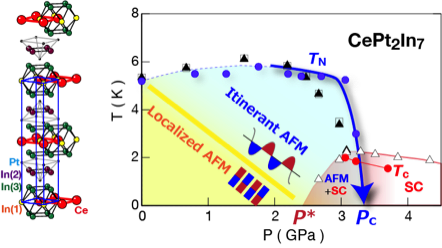
(Left) Crystal Structure of CePt2In7. (Right) P-T phase diagram for CePt2In7.

59Co nuclear spin-lattice relaxation has been measured for the heavy fermion superconductor CeCoIn5 in a range of applied fields directed parallel to the c axis. An enhanced normal state relaxation rate, observed at low temperatures and fields just above Hc2(0), is taken as a direct measure of the dynamical susceptibility and provides microscopic evidence for an antiferromagnetic instability. The results are well described using the self-consistent renormalization (SCR) theory for two-dimensional antiferromagnetic spin fluctuations, and parameters obtained in the analysis are applied to previously reported specific heat and thermal expansion data with good agreement.
If you have interest, please read the following article: H. Sakai, S. E. Brown, S.-H. Baek, F. Ronning, E. D. Bauer and J. D. Thompson, Phys. Rev. Lett. 107 (2011) 137001.
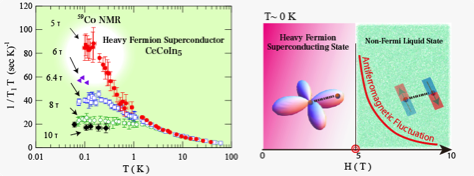
(Left) Temperature dependence of 59Co-NMR relaxation rates divided by temperatures at several applied fields along the c axis in the normal state of the heavy fermion superconductors CeCoIn5. (Right) Schematic picture to illustrate the development of antiferromagnetic fluctuation in CeCoIn5 near 0 K under magnetic fields along the c axis.

The first NMR study of americium dioxide (AmO2) has been done. More than 30 years ago, a phase transition was suggested to occur in this compound at 8.5 K based on magnetic susceptibility data, while no evidence had been obtained from microscopic measurements. We have prepared a powder sample of 243AmO2 containing 90 at. % 17O and have performed 17O-NMR at temperatures ranging from 1.5 to 200 K. After a sudden drop of the 17O NMR signal intensity below 8.5 K, at 1.5 K we have observed an extremely broad spectrum covering a range of ~14 kOe in applied field. These data provide the first microscopic evidence for a phase transition as a bulk property in this system. In addition, the 17O NMR spectrum has been found to split into two peaks in the paramagnetic state, an effect which has not been reported for actinide dioxides studied up to now. We suggest that the splitting is induced by self-radiation damage from the alpha decay of 243Am.
If you have interest, please read the following article: Y. Tokunaga, T. Nishi, S. Kambe, M. Nakada, A. Itoh, Y. Homma, H. Sakai and H. Chudo, J. Phys. Soc. Jpn. 79, 053705 (2010).
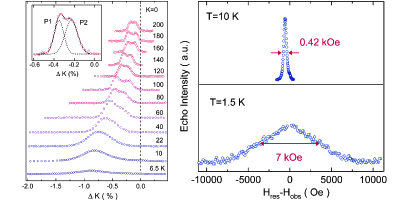
(Left) Temperature dependence of the field sweep 17O-NMR spectrum at a series of temperatures T > 6.5 K, with about 7 T magnetic field. The inset shows an example of a fitting with a double-Gaussian function to the data at 120 K. (Right) Comparison of the 17O NMR spectra obtained above and below T0. The full widths at a half hight are 0.42 and 7 kOe at 10 and 1.5 K, respectively. ("Oe" is a unit of magnetic field: 10 kOe = 1 Tesla.)

Based on analysis of nuclear (115In) spin-lattice relaxation-time measurements on the heavy-fermion superconductor CeIrIn5, (q, ω, T)-dependences of the dynamical susceptibility Imχ(q, ω) near the antiferromagnetic wave vector Q at low energy ω ~ 0.0001 meV have been estimated. The T-behaviors found, Imχ(q, ω) ~ T-3/2 and antiferromagnetic correlation length ξ ~ T-3/4, are consistent with quantum critical behavior for a three-dimensional antiferromagnet (d=3, z=2) having a spin-density-wave instability.
If you have interest, please read the following article: S. Kambe, H. Sakai, Y. Tokunaga and R.E. Walstedt, Phys. Rev. B 82, 144503 (2010).
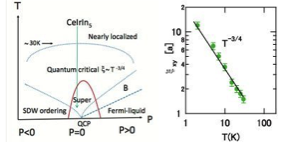
(Left) Schematic phase diagram for CeIrIn5. (Right) Temperature dependence of the magnetic correlation length in the basal plane (ξxy) in unit of lattice parameter a=4.666 Å.

We revealed that a positive muon implanted into f-electron compound PrPb3 forms a novel spin system Pr - μ+ - Pr together with nearest neighbor Pr nuclear spins by means of μ+SR. The interaction between the spins is mediated by f-electrons, which is completely different from that in previously reported a-few spin systems made up of a μ+ spin and nuclear spins.
If you have interest, please read the following article: T. U. Ito, W. Higemoto, K. Ohishi, N. Nishida, R. H. Heffner, Y. Aoki, A. Amato, T. Onimaru, and H. S. Suzuki, Phys. Rev. Lett. 102, 096403 (2009).
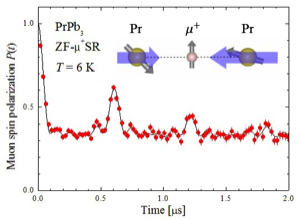
A zero-field μ+SR spectrum in PrPb3. The inset shows a schematic diagram of Pr - μ+ - Pr. The blue arrows designate f-electron magnetic moments induced by the hyperfine interaction with Pr nuclear spins.